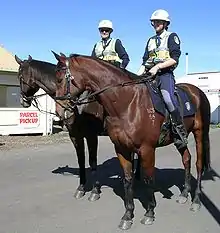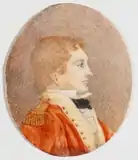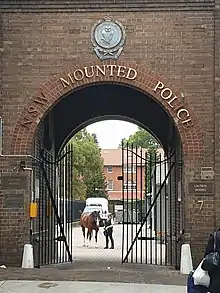New South Wales Mounted Police
The New South Wales Mounted Police Unit is a mounted section of the New South Wales Police Force. Founded by Governor Thomas Brisbane, on 7 September 1825,[1] the Mounted Police were recruited from a British military regiment stationed in NSW at the time, to protect travellers, suppress convict escapees and fight Indigenous Australians. The force remained the mounted division of the British Army in the colony of New South Wales until 1850, when it took upon a more civilian role.[2] The NSW Mounted Police Unit is the oldest continuous mounted group in the world.[3][4]
| New South Wales Mounted Police Unit | |
|---|---|
 | |
| Active | 7 September 1825 - present |
| Country | Australia |
| Agency | New South Wales Police Force |
| Type | Mounted police |
| Headquarters | Redfern |
| Structure | |
| Sworn Officers | 36[1] |
| Grooms | 9[1] |
| Equipment | |
| Animals | 38 horses[1] |
History
After the Bathurst War between the British and the Wiradjuri people concluded in 1824, it was deemed necessary that a mounted infantry division be formed in New South Wales. In 1825, the British Colonial Office approved the idea and agreed to finance the troopers for the mounted force who were to be recruited from the British Army stationed in the colony. The New South Wales government provided funding for the cost of the horses and equipment. Colonel William Stewart of the 3rd Regiment organised the first detachment by selecting 28 soldiers from his force. This first detachment of mounted troopers, which was based at Bathurst, became active on 4 November 1825. The second detachment was formed in February 1826 and was based at Wallis Plains which is now called Maitland.[5]
While the Bathurst division were quickly utilised to capture escaped convicts, the Wallis Plains unit were deployed in the repression of Aboriginal resistance along the newly colonised area of the Hunter Valley. Lieutenant Nathaniel Lowe, who volunteered for the Mounted Police from the 40th Regiment, ordered multiple executions of Aboriginal prisoners as part of the campaign. Reinforcements of mounted infantry under Ensign Archibald Robertson of the 57th Regiment were required from Sydney and Newcastle throughout the latter half of 1826 to force the local Wonnarua people to submit to British rule. With the aid of armed settlers such as Robert Scott of Glendon, the Mounted Police conducted raids of local Aboriginal camps and by early 1827 resistance in the area ended.[6] Lieutenant Lowe was brought before a court to face charges of extrajudicial murder, but was acquitted and reinstated to his position.[7]

By 1829 the force was commanded by Lieutenant Colonel Kenneth Snodgrass. There were four areas of operation, the main detachment of the unit, incorporating the Governor's guard, was stationed in Sydney at the Belmore Barracks (located on the present site of the Central railway station). There were three country divisions based at Bathurst, Goulburn and Maitland. Lieutenant Lachlan Macalister, who was also a prominent pastoral capitalist in the colony, was placed in charge of the Argyle Division and later commanded the Bathurst Division.[8] Capturing outlaw gangs of escaped convicts, commonly referred to as bushrangers, was the main employment of the Mounted Police at this time. The Bushranging Act of 1830 which enabled the arrest without warrant of anyone suspected of being a criminal aided the force in their duties.[9]
The Mounted Police absorbed the Mounted Orderlies (established as a replacement for the Governor's Body Guard of Light Horse) in 1836.[10] This unit existed as a separate component of the mounted police until at least 1860.[11]

In 1837, Major James Winniett Nunn of the 80th Regiment became Commandant of the Mounted Police. The British colony at this time was spreading into regions that are now known as Port Phillip and the Liverpool Plains. Resistance by the Gamilaraay people to occupation in the Liverpool Plains area prompted the NSW government to send a large force led by Nunn to suppress this opposition. In early 1838, Nunn conducted a two-month sweeping operation along the Gwydir and Namoi Rivers that culminated in the Waterloo Creek massacre, where his mounted troopers shot dead at least 50 Gamilaraay people. This operation coincided with numerous other massacres of Aboriginals in the area by armed gangs of British settlers, of which the Myall Creek massacre is the best known. An inquiry into Nunn's campaign exonerated him of any wrong doing and he continued to command the Mounted Police as they expanded their operations in the south of the colony.[12]
By the mid 1840s, the Mounted Police consisted of around 150 troopers in five divisions distributed among 35 stations ranging from Muswellbrook in the north, Portland Bay in the south and Wellington in the west. The much cheaper Border Police had by this time usurped most of the functions of the Mounted Police and the cost of maintaining the force was deemed too expensive for the colonial government to run. In 1850 its paramilitary function was ceased and the force took on the more civilian role that it has in the present day. The frontier duties of repressing Aboriginal resistance was largely taken on by the Native Police.[13]

For over a century the New South Wales Mounted Police were a key part of policing, as horses were the main form of transport. The unit was formed three years before the London Mounted Police[14] and 38 years prior to the 1873 formation of the Royal Canadian Mounted Police.[15] By the 1900s the Mounted Police had grown to a strength of over 800 personnel and more than 900 horses. Most stations throughout the state had mounted units attached to them. It was around this time that they unit was moved from Belmore Barracks, to allow for the construction of the present Central railway station, to a temporary base at Moore Park, and then on to the Bourke Street Police complex at Redfern in 1907.
Horses
Horses used by the mounted Police generally include a variety of breeds, including heavier horses such as warm bloods, draft horses and Clydesdale crosses. Historically horses were donated to the section, and ex race horses have been included in the donations. It can take up to two years to train a mount. [16]
Modern-day duties
Duties include traffic and crowd management, patrols, and ceremonial protocol duties (including taking part in the Queen's Jubiliee celebrations in London).[17] Currently the NSW Mounted Police has a strength of 36 officers and around 38 mounts. Nine full-time grooms are employed to assist with the care of the horses and running and maintenance of the stable complex.[1] The Mounted Police have recently been trialling iPads to give them access to the same information the non mounted police have [18]
References
- "History - NSW Police Online". Police.nsw.gov.au. 11 January 2011. Archived from the original on 2 April 2016. Retrieved 3 April 2016.
- Stanley, Peter (1986). The Remote Garrison. Kenthurst: Kangaroo Press.
- They have a great group of riders that work there. Mounted Police Archived 19 February 2011 at the Wayback Machine at 'Thin Blue Line' unofficial NSW police site.
- Roth, Mitchel (December 1998). "Mounted police forces: a comparative history". Policing: An International Journal of Police Strategies & Management. 21 (4): 707–719. doi:10.1108/13639519810241700.
- Connor, John (2002). The Australian Frontier Wars. Sydney: UNSW Press.
- Connor, John (2002). The Australian Frontier Wars.
- "Supreme Criminal Court". The Sydney Gazette and New South Wales Advertiser. XXV (1349). New South Wales, Australia. 21 May 1827. p. 2. Retrieved 24 April 2018 – via National Library of Australia.
- "LACHLAN MACALISTER". The Argus (Melbourne) (27, 075). Victoria, Australia. 27 May 1933. p. 4. Retrieved 24 April 2018 – via National Library of Australia.
- O'Sullivan, John (1979). Mounted Police in NSW. Adelaide: Rigby.
- Martin, Robert Montgomery (1839). Statistics of the Colonies of the British Empire in the West Indies, South America, North America, Asia, Australia, Asia, Africa and Europe ...: From the Official Records of the Colonial Office. W.H. Allen & Company. p. 427.
- Sargent, Clem (1998). The Governor's Body Guard of Light Horse. Sabretache: The Journal of the Military Collectors Society of Australia. 39. p. 12. ISSN 0048-8933.
- Milliss, Roger (1992). Waterloo Creek. Ringwood: McPhee Gribble.
- O'Sullivan, John (1979). Mounted Police in NSW.
- "Metropolitan Police Service – History of the Metropolitan Police Service". Metropolitan Police. Archived from the original on 26 April 2009. Retrieved 6 May 2009.
- History of the RCMP Official Canadian police site
- "Horses of the Mounted Unit - NSW Police Online". Police.nsw.gov.au. 11 January 2011. Retrieved 3 April 2016.
- "No Republic! Australians for Constitutional Monarchy - NSW Mounted Police Unit farewelled as they leave for Queen's Diamond Jubilee Pageant". Norepublic.com.au. 11 May 2012. Retrieved 3 April 2016.
- "Police rein in iPads". Canberratimes.com.au. 22 July 2012. Retrieved 3 April 2016.